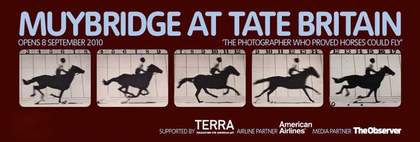About 25 years ago, I bought a group of works by Eadweard Muybridge, and I have been collecting bits and pieces by him ever since. I find that his motion studies – the images of animated animals and humans, which everyone has seen – represent an absolutely fascinating merger of artistic and scientific ideas. The two disciplines had been on a divergent course since the Renaissance, and Muybridge is one of the people who brought them back together.
Did he see himself as an artist, a photographer, or a scientist? I believe he considered himself an artist. Francis Bacon was influenced by him. Like Albrecht Dürer, Muybridge was concerned with measuring and visualising. But we should also think of him as a director. He utilised aspects of theatre and narrative in combination with highly sophisticated techniques (in terms of lighting and camera work) in a way that significantly influenced film and animation. He would project his motion studies with his Zoopraxiscope, the final and biggest occasion being at the Chicago World’s Fair in 1893, where he used a whole building – one of the first moving pictures projected in such a way. Crucially, Muybridge showed that the brain can integrate information and turn things that are sequential into animations. I believe he was the first director. Along with Francis Frith and Roger Fenton, he represents a prototype of what directors became.
Very much an innovator, Muybridge famously produced the great 360-degree panorama of San Francisco, which was at the time, I think, the biggest ever made. Taken from the top of Mark Hopkins’s house while it was under construction, its thirteen mammoth plates were set vertically and had to be meticulously managed. At seventeen feet long, it is a tour de force of photography.
Muybridge started as a landscape photographer, and is known for his images of Yosemite. However, his landscape work, published by Bradley and Rulofson, seems to have been eclipsed in the minds of curators and scholars by that of Carleton Watkins, to whom, some say, he was an assistant. It is fair to say that Muybridge probably had a slightly more romantic approach, inventing devices such as the ‘sky filter’ so that he could photograph clouds without suffering blotchiness as a result of overexposure. But his later South American pictures lacked this romantic aesthetic, and must be a reflection of his state of mind at the time. He took them for the Pan American Railway, and they are extraordinary. There’s a certain bizarreness to them, particularly in the way people are posed.
People who knew Muybridge when he was in Pennsylvania doing the animal locomotion work said he walked around in old clothes and a hat with a hole in it, and was very distracted when he spoke to them. But apparently he was fantastic on the lecture circuit (he lectured to raise the money needed to produce the locomotion pictures). I imagine a man who did not interact well with people, but came alive when he talked about his work.

